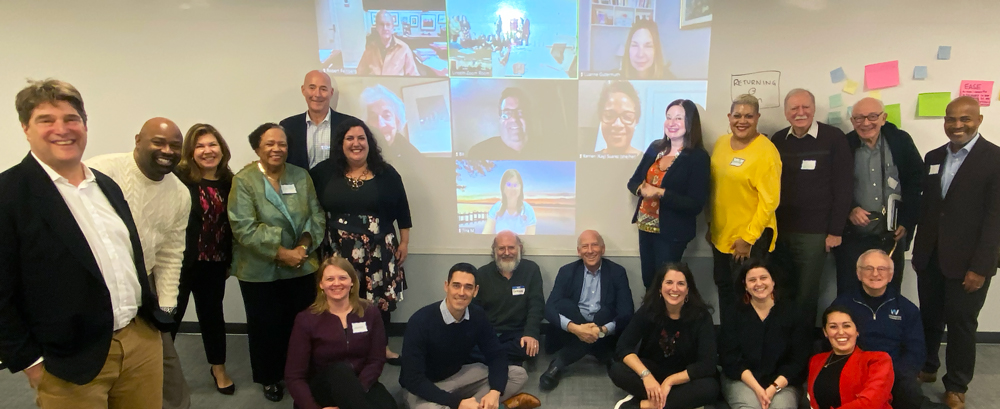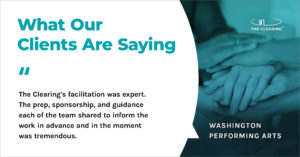Washington Performing Arts (WPA) champions the arts as a unifying force. Through collaborations with artists, educators, community leaders, and institutional partners, it brings wide-ranging artistic programs to stages, schools, and neighborhoods throughout our nation’s capital, and, with a virtual platform, it’s able to share its work throughout the world.
The Clearing partnered with WPA’s Strategic Planning Task Force to develop a strategic plan that articulates how WPA thinks about its programs, how it builds community and collaboration and defines the operational goals essential for the organization’s success, sustainability, and resilience over the next five years.
The Situation
As WPA emerged from the pandemic, it faced similar challenges to peer organizations throughout the field: navigating the ever-changing landscape of shifting dynamics around attending live performances; defining a programmatic mix to serve its mission, vision, and guiding principles; engaging audiences; and strengthening revenue while building grounded, long-range budgeting and revenue models. With two former Washington, D.C., arts professionals, Andrea Bachinski and Abbie Beekman, now serving as TC consultants, The Clearing was uniquely positioned to support WPA’s navigation of these challenges.
Since WPA’s founding in 1965, its commitment has been Everybody In, Nobody Out (EINO). This comes to life as diversity in leadership representation and programming genres; affordable tickets that make live art accessible for veterans and service members, as well as schoolchildren and their caregivers; and artistic partnerships at varied venues that honor the diversity of WPA’s artists, audiences, patrons, local businesses, and peer institutions.
As WPA embarked on its planning journey, it set up a strategic planning task force. Because EINO is foundational to everything that WPA does, the task force’s membership was as broad as the organization’s programming, including members from across WPA’s community – Board, Junior Board, Women’s Committee, and staff management team. Not only was there a diversity of perspective, but there was a depth of organizational ties – many members had participated in WPA’s gospel choir as children!
As you can imagine, with such a long-time investment in WPA, the idea of reimagining WPA’s future brought out a host of differing opinions and feelings across the Task Force. To support momentum and ensure that the plan included the fewest, most important items and initiatives the organization should focus on to thrive, the Consensus PRIME was leveraged throughout the engagement. Using this concept helped make it clear that the goal was not for everyone to agree on everything, but instead that the process of imagining WPA’s future would be explicit, rational, and fair – and that everyone’s inputs would be heard.
How We Did It
To build the strategic plan, The Clearing hosted a series of facilitated sessions over eight months, with each session’s outcomes serving as the building block for the next session. The initial sessions were used to align around WPA’s guiding principles, vision, and mission and what success in five years might look like. From there, the Task Force created strategic goals and objectives centered around the organization’s guiding principles. The final session was used to develop metrics for the goals, objectives, and initiatives they had created. The facilitated sessions broke down the complex nature of writing a strategic plan into smaller, manageable tasks, maintaining the task force’s momentum.
The team also used a maneuver from their performing arts days to maximize sessions with the task force: setting the right stage. The success of a performance hinges on the right venue, so the team was mindful of where and what modality to use for each session. Most were facilitated at The Clearing’s offices with a virtual element for those who could not attend in person. This hybrid style was inclusive and created opportunities for everyone to participate and collaborate. Other sessions were in-person or virtual only to support the outcomes the task force was working towards. For example, the particularly challenging and fast-paced session where the group was editing and wordsmithing their objectives together required that everyone was in the same room. A different session that was discussion-based was virtual. Understanding WPA’s EINO value and the flexibility for the task force to meet in the way they could be most effective was key to the success of the planning process.
During the sessions, the team deployed two additional key PRIMES.
- Open-Close-Decide. This PRIME allowed for open discussion around initiatives. Open-Close-Decide is perfect for taking groups from the “Big Idea” phase to narrowing down ideas to the most important ones because it provides space for brainstorming before grounding things in decisions. It also plays well with our first priority: consensus.
- Commitment Versus Attachment. Given its long history, WPA had many board members and leaders who were very attached to certain ideas, certain programs, or certain performance elements. This PRIME helped The Clearing broach a potentially sensitive subject: what’s popular versus what you’re attached to versus what generates revenue for WPA. We worked through the idea that if everyone participating in the strategic planning process was committed to a vibrant future for WPA, they couldn’t be attached to any one way of doing things or any one legacy program.
When The Clearing put it all together with the task force, a strategic plan emerged that connected the history of WPA with a sustainable organizational future.
The Impact
The key outcome was helping WPA produce a future-forward strategic plan that would be adopted by its Board. We’re proud to report the strategic plan was approved by WPA’s Board in the summer of 2023. While achieving that outcome was our priority, we take even greater pride in what WPA leadership said about the overall planning process.
As part of the presentation to the board before the vote, WPA’s Elizabeth Racheva, Vice President of Strategic Planning and Chief Advancement Officer, told members that she “had been involved in numerous other strategic planning processes, and it was the most inclusive process she had ever participated in.”
Upon reflecting on the planning process, Jenny Bilfield, WPA President & CEO, shared that it was “a pleasure and honor to work with The Clearing through this process. You have so measurably helped us advance our work and engage our special community in transformative and highly inclusive ways.”
Those kind words reflect the type of impact we hope to have in every engagement and demonstrate how The Clearing’s people-first, inclusive approach to consulting drives optimal outcomes for clients across industries and sectors.

WPA Strategic Planning Task Force (SPTF) following one of the Strategic Planning Sessions
If you’re thinking about strategic change or organizational transformation – whether that’s refreshing an existing plan or starting from scratch – we can help. Reach out anytime.







 The Clearing’s Employee Experience
Improvement model, adapted from Itam
& Ghosh, 2020, focuses on three objectives:
The Clearing’s Employee Experience
Improvement model, adapted from Itam
& Ghosh, 2020, focuses on three objectives: 














